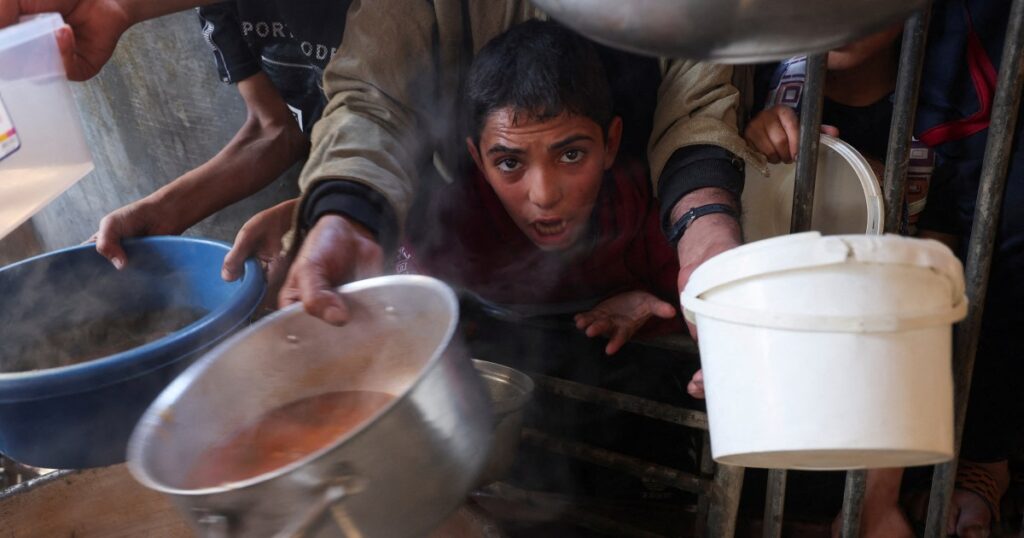As the humanitarian pause took impact in Gaza, footage of the huge destruction within the northern a part of the enclave has began to trickle in.
Seeing these photographs of devastation, one can not however consider Thomas Friedman’s reference to what he calls the “Hama rules” in an article he revealed with The New York Times on October 14.
A neologism he coined a few years in the past, it refers to then-Syrian President Hafez al-Assad’s violent razing of the town of Hama in 1982 that killed greater than 20,000 Syrians. Friedman argues that brute drive instructions legitimacy within the Middle East. This concept is deeply problematic, however the scale of destruction in Gaza means that the Israeli authorities and the army have embraced it.
Indeed, Israel’s warfare on Gaza bears placing similarities to occasions in Syria. But we’d like not go way back to the Nineteen Eighties to seek out these parallels.
In 2011, when Hafez’s son, Syrian President Bashar al-Assad, confronted a nationwide rebellion towards his rule, he unleashed a violent marketing campaign towards the protesters that quickly became a civil warfare.
The ways of collective punishment he used, aided and abetted by the systematic dehumanisation of the opposition by some elements of Syrian society, are just like what we’re seeing in Gaza as we speak.
In the earliest levels of the battle, Israel justified an entire siege on Gaza, reducing off the provision of meals, water, electrical energy and gas, by way of systematic dehumanisation of its residents. Defence Minister Yoav Gallant referred to as the Palestinians “human animals”, whereas Prime Minister Benjamin Netanyahu spoke of a “struggle between the children of light and the children of darkness”. Such language utilized by Israeli officers appeared to make using hunger as a weapon of warfare acceptable.
This sentiment seeped into social media the place movies appeared of Israelis rapaciously mocking the residents of Gaza below siege by indulging in clear water or lavish meals. Some stooped even decrease, producing racist vignettes making enjoyable of Palestinian victims of Israeli bombardment.
And as Israeli army targets got here to incorporate Gaza’s hospitals and different civilian constructions, the dehumanisation marketing campaign of the Palestinian inhabitants additionally expanded. The official authorities narrative, maintained by Netanyahu and others, states that “terrorists had used hospitals as military bases”. Accordingly, medical employees turned “terrorist collaborators” whereas sufferers and households who had sought refuge in medical services have been – prepared “human shields”. Their deaths – even within the eyes of Israeli docs – have been subsequently justified.
But what appears misplaced within the current second is that this marketing campaign of dehumanisation just isn’t distinctive. Since 2011, al-Assad has relied on eerily related methods to justify almost similar army sieges and assaults on civilian infrastructure in rebel-held territories.
The 2015 siege in town of Madaya close to Damascus bears a placing resemblance to the present Israeli weaponisation of hunger in Gaza. As the al-Assad regime dismissed the native residents as “agents of terror”, Syrians in government-controlled areas purchased into the narrative.
As the folks of Madaya have been diminished to subsisting on leaves, Syrian social media was crammed with photographs and movies of detractors having fun with lavish meals and mocking their hunger. The Twitter hashtag “solidarity with the siege of Madaya” was flooded with culinary content material to additional brutalise an already brutalised inhabitants below siege. More than 420 folks died in Madaya, together with dozens of youngsters, on account of the blockade.
The al-Assad regime continued this coverage of “starve or surrender” in a number of rebel-held territories, together with Aleppo, Ghouta, and Daraya, with none significant response from the worldwide neighborhood.
In parallel, the al-Assad regime additionally focused civilian infrastructure as a warfare tactic, particularly hospitals. According to the International Rescue Committee, solely 64 % of hospitals and 52 % of main healthcare centres stay operational in Syria on account of assaults on healthcare services. The al-Assad regime has justified these offensives below the nebulous banner of “countering terrorism”, claiming that 119 healthcare services have been “taken over by terrorist groups”.
But many of those services have been placed on a deconflicting listing, shared with Damascus, and because the UN has identified, it was working not less than one in every of them. An investigation by Human Rights Watch has additionally challenged the Syrian regime’s claims, stating they might not discover any proof of army tools or personnel close to the hospitals once they have been focused.
Israel is at the moment enjoying by al-Assad’s guidelines of warfare, largely as a result of to this point the Syrian chief has not been held to account for these warfare crimes, or the dehumanisation of his those who enabled them.
On the opposite, al-Assad has emerged from isolation by the worldwide neighborhood, notably after the February 2023 earthquakes in Syria. He has ridden the wave of normalisation by attending Arab League summits and has even been invited to the upcoming United Nations Climate Change Conference in Dubai.
Indeed, the victims of the Syrian regime’s brutality have recognised the parallels with Gaza. Zina Najjar, a Syrian activist, posted on X that what’s transpiring at the moment within the besieged enclave is analogous to the occasions of Madaya eight years in the past. Recollecting the brutal siege, Najjar warns that “international failure and silence” in Syria is encouraging the identical crimes in Gaza.
That worldwide silence should finish instantly, each in Syria and in Gaza. More pressingly, the Israeli authorities should face swift pushback from the worldwide neighborhood for its dehumanisation of the folks of Gaza and for the collective punishment it’s inflicting on them.
Otherwise, as in Syria, hunger and the deliberate bombardment of hospitals as warfare ways will grow to be chillingly normalised as par for the course.
The views expressed on this article are the creator’s personal and don’t essentially mirror Al Jazeera’s editorial stance.
https://www.aljazeera.com/opinions/2023/12/3/israel-is-using-the-same-tactics-in-gaza-that-al-assad-employed-in-syria?traffic_source=rss


